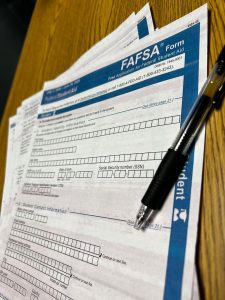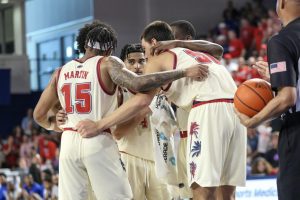While everybody else was cramming for their finals last December, 12 engineering students were figuring out how to make a concrete canoe that would float.
Five months later, FAU’s student chapter of the American Society for Civil Engineers came up with a 21-foot, bright blue, 150-pound canoe. For a touch of irony, and because they weren’t convinced it would, they dubbed it Damn It Floats.
And Damn It Floats floated, surpassing the students’ – and even their advisor’s – expectations, since it was their first time in this competition. Out of the 19 teams competing in a regional competition in Tallahassee, the FAU group ranked tenth.
While ecstatic about ranking, they realize they have much to learn. However, they’re confident that they will one-day win the gold for FAU.
The club’s advisor, Prof. Stephan Nix, agrees that the team did well: “I’ve been on some teams where they did this [concrete canoe racing] a lot longer, and these teams didn’t do as well as ours,” says Nix, who’s also the chairman for the civil engineering department.
While Damn It Floats was staying afloat during the April 4-6 weekend competition, some other schools – veterans in the races – watched helplessly as their canoes sank.
Student Body President Pablo Paez says this project can help put FAU in the public eye. He says, “This is great for FAU. The fact that one of our student clubs has been able to accomplish so much. It’s good for the school, the student body, and for all of us.”
Row, row, row, a concrete boat?
The students say they get some weird stares when they tell people about their concrete canoe.
“At first glance, it seems to be ridiculous to spend so much time on a project like a concrete canoe. What is the purpose? Are we completely crazy to play with concrete, to spend money, to spend more time in it than in other sports or activities?” student Florent David says.
David and crew aren’t crazy – and neither are the thousands of students who compete nationwide – but why are they using the same material that lines sidewalks to make canoes?
Because of the challenge, according to Lou Graef, ASCE’s national president.
“Making concrete float is an unusual challenge that offers civil engineering students valuable lessons crucial to the work they will be doing to design and maintain America’s infrastructure,” Graef says.
Prof. Nix concurs, saying, “The product itself is kind of silly, but the process itself requires good planning and good engineering.”
Concrete in boats is not a new concept. During World War II, the U.S. used concrete ships were produced in great numbers since concrete was cheaper than steel.
Since the 1970s, by holding regional races, ASCE has brought back concrete boats’ popularity. The competition went national in 1988 and is often referred to as the “America’s Cup” for college civil engineering.
“Sponsoring this event is an investment in the future,” says Mike Shydlowski, the CEO of Master Builders – a concrete prodution company based in Cleveland, Ohio – that’s also the sole sponsor of the competition. “It provides a unique opportunity for students to get hands-on, real life experience in design and construction principles, as well as project management and team building.”
To be future engineers, teamwork is essential, David says, “[This] is the normal work of an engineer and it will be my job. So this experience proves that I am able to work in a team and have fun doing that.”
Creating a team atmosphere was Nix’s main reason for wanting to do this project. Nix, who’s only been at FAU for a year, knew he wanted FAU to join this competition before he even accepted the job here.
Nix says, “I knew I wanted them to share a focus.”
From dream to reality
To find wood to build the canoe’s mold, team members dug through garbage. To mix the concrete to the right consistency, they improvised.
Every team member was assigned a different task. John Langford was part of designing the haul’s design. Langford says that they were building “a sound base” that will be enhanced in the future.
Hernando Nieto, ocean engineering major, says he’s learned much about civil engineering through this project.
“I learned many things that I would not have learned in a classroom setting, for example having a backup plan when things don’t go as planned, cost of materials, troubleshooting, time management, teamwork,” Nieto says.
David had the task of finding the concrete. He says it wasn’t easy doing this for the first time.
“It is not easy when you start from zero to achieve this goal. When you do not know all about the concrete technology, when you have a lot to learn about the experiments and standards used to determine the concrete properties … You have everything to learn,” David says.
Not everything they learned was about engineering. The team had to fundraise and seek donations. After receiving some money from the civil engineering department and College of Engineering, they made a presentation before the Boca Raton student senate for the rest of the money.
Senate Speaker Nick Kalman says, “Speaking for the senate, it was a bill asking for a lot of money, for a program that never came up before. We decided to give them the whole amount, because it’s great exposure for FAU and the engineering department.”
The senate voted unanimously for the students and the canoe to go to the competition. As Kalman banged his wooden gavel, he joked, “Now, make sure you guys don’t sink.”
Better luck next time
Victory in future competitions is an idea that’s not sinking. The club is already planning FAU’s second canoe. Before starting, they’re reevaluating what they did wrong this year.
“We made some mistakes this year, but we learned by just doing this,” Langford says.
For instance, they overbuilt this year’s canoe. It was so sturdy, that Nix bets, “it could survive a demolition derby.”
Nix says he wouldn’t be surprised if next year’s canoe was half the weight and sleeker – “it’ll be a quantum leap from this year’s.” The winning canoe, the IntimiGator, was from the University of Florida, weighed 105 pounds. UF has been in the competition since 1976.
“This first experience will definitely help us out next year. We have gone through a huge learning curve and will make us a better and more competitive team next year,” Neito says.
All of the team members believe that one day, FAU will be triumphant.
Celine Rosay, team captain and president of the FAU club says, “I’m sure we’ll be contenders for the national finals.”
If this happens, David says, this can do a lot for the university: “If we win this competition some day, FAU will count for this world of civil engineers and we could be recognized as good project and civil engineers.”











